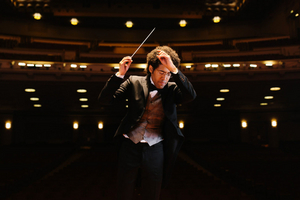Review: Rafael Payare Conducts The San Diego Symphony Orchestra at the Jacobs Music Center

It's an exciting time for San Diego classical-music lovers. There are more concert choices than ever before, and performance quality has been impressive for everything from solo recitals to symphony concerts and operas. The La Jolla Music Society's $82 million dollar multi-stage Conrad Prebys Arts Center held its first concert early this year, and the San Diego Symphony has begun its own multi-million dollar project to turn its waterfront summer venue into a state-of-the-art amphitheater that will host year-round concerts and events.
The Symphony's newly appointed music director and conductor Rafael Payare topped it all as he launched his first official season with the orchestra. From the packed lobby to the standing ovation and three curtain calls that followed the season's first concert, the feeling was electric. Payare began with a contemporary tone-poem/symphony by Californian Mason Bates. He concluded after intermission with Mahler's massive fifth symphony (over 70 minutes in five movements).
Devoting the first half of the program to Bates's "Alternative Energy" was risky given today's generally conservative audiences, but appropriate for a night of spirited chance-taking. And the piece certainly lives up to the "Energy" part of its title. Bates

is among the most in-demand contemporary composers at least partly because of his exceptional ability to weave elements of pop music into classical structures. He combines a PhD in composition from the University of California, Berkeley with beat-generating gigs at dance clubs under the name DJ Masonic. The four movements of "Alternative Energy" are a musical description of the state of energy production in centuries from the 19th through a projected 22nd. In part the piece is a grim prediction of the effects of climate change. The 19th Century movement is replete with sounds seldom heard at a symphonic concert. These include metallic clinking "notes" from part of a motor vehicle. In the hall's recently added large side video-screens the unorthodox instrument proved to be the grille of an ancient Ford. The work also features recorded sounds invoked at a laptop the composer often "plays" himself, though on this evening Symphony CEO Martha Gilmer announced that Bates was sorry he was unable to attend. Concertmaster Jeff Thayer played the work's bluegrass-inspired main theme which subsequently appeared in various altered guises throughout the work, eventually returning to Thayer's beautifully-toned Stradivarius in the final movement.
The second movement introduces atomic energy by using particle-accelerator sounds recorded at Chicago's Fermilab. The movement is indebted to minimalism, though closer to John Adams than Phillip Glass. "It's fun" was the comment I heard most often about the entire symphony, and I agree more than not, but impatient boredom was my main reaction to the second movement's repetition and overuse of basically ugly noise, no matter how cleverly representative of the Atomic Age. Perhaps its driving club-beats lead to rapturous trances on an actual dance floor.
The third movement shifts energy invention and production to China as the West is presumably replaced on the scientific frontier by Asia. An exotic scale and a few bent notes let us know we're in China amidst the evening's most icily austere moments, an indication of climate-caused desolation, but the movement's climax comes with a frenzy of mallets and brass.
And it's on to the 22nd Century when Iceland is the last inhabitable portion of the globe. No wonder our president wanted to buy the nearby Greenland. The mood is somewhere between gentle and resigned. Recorded bird calls suggest a pastoral setting in a dying world.
Payare conducts with passion, sometimes with so much concentrated intense energy that there are longer than usual pauses between a work's movements as he wipes his brow and composes himself before returning to the dais. After conducting the driving, metronomic rhythms of "Alternative Energy," I believe he can skip aerobic classes this week.
Payare chose Mahler's fifth symphony at the beginning of his first full season because, he said, "I see it as a great piece to start this new journey together," a musical metaphor for his journey as the San Diego Symphony's new conductor. As with the Bates symphony, he was all-in, swaying, gesturing to soloists and sections, almost dancing in sympathy with Mahler's emotional excesses. His active style is reminiscent of both his fellow Venezuelan Gustavo Dudamel and conductor Leonard Bernstein-distracting to some but winning for a large majority. After all, if the performer feels no emotion, why should the audience?
From the opening trumpet call, stirringly played by ex-Marine and now Principal Trumpet Christopher Smith, the journey began, and it was by turns thrilling and poignant. The brass section, complete with seven regal French horns, excelled throughout. Only the beautiful slow fourth movement missed near perfection as the violins, perhaps abetted by hall acoustics, were more steely than lush. Strict tempo adherence in the Bates was discarded for frequent well-chosen changes in tempo for Mahler. Dynamic changes were extreme in both cases, but still effective from whispery solos to thundering climaxes.
The orchestra improved tremendously during Jahja Ling's lengthy tenure, improved to the point that guest conductors rarely asked for anything the orchestra couldn't deliver. If this concert is a good indicator, Payare will take performances to a new level with demands for technique able to respond to his direction at tempo and dynamic extremes without losing the emotion of every phrase. Early reports indicate that the musicians have responded enthusiastically; it certainly seemed so on this evening.
Payare will conduct a total of 10 programs before Conductor Laureate Jahja Ling returns for concerts in early December.
This concert was presented by the San Diego Symphony on Saturday, October 5, 2019 in the Jacobs Music Center's Copley Symphony Hall and repeated on October 6 in the same hall. Payare photo, credit San Diego Symphony. Bates photo from his website.
For future programming and ticket information visit the San Diego Symphony website.
Reader Reviews

Videos
